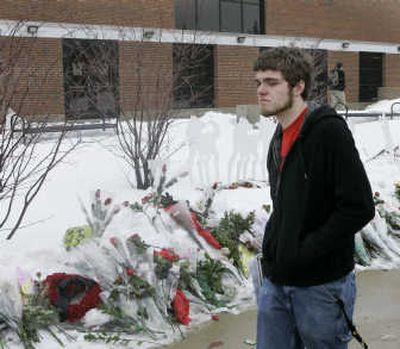NIU students return to a changed reality

CHICAGO – In chemistry class, they talked chemistry.
In business calculus, they discussed business calculus.
And in criticism of public rhetoric Monday at Northern Illinois University, they spent the hour talking about the Feb. 14 massacre that left five students and the shooter dead and 16 wounded.
“It was very clear that a few students really needed to talk,” said associate professor Ferald Bryan, who allowed the class to stray from its syllabus. “One said she hadn’t even shared what she has experienced with her family.”
On the first day of classes since a former graduate student opened fire in a crowded NIU lecture hall and then killed himself, each class waded through the campus’ new reality in its own way.
Grief counselors were stationed in every classroom, and most, if not all, opened classes by briefly offering an ear if students wanted to talk. Some, like those in Bryan’s class, took advantage of the opportunity.
But many others went right back into academics – a relief to junior chemistry major Andy Prochaska, 21, of Algonquin, who said he was thankful to be “taking boring notes” again. “It’s nice to be back in it,” he said.
Also Monday, one of the students most seriously wounded during Steven Kazmierczak’s attack, 20-year-old Maria Ruiz-Santana of Elgin, was released from Advocate Good Samaritan Hospital in Downers Grove after a faster-than-expected recuperation.
Her father, Alfredo Ruiz, said Maria is eager to resume her criminology studies at NIU even though she will remain at home for the time being to recover from shotgun wounds to her head, neck and chest.
“She feels sorry for this guy who was shooting,” Ruiz said. “She doesn’t have any anger against him.”
As Monday dawned icy and gray on campus, students with bags slung over their shoulders and headphones in their ears shot brief but hardened glances at the police tape circling Cole Hall, the scene of the shootings.
By midmorning, campus authorities had taken down the tape, but students said the mood remained dour. Instead of walking in the usual large groups of chatter and laughter, they moved to their classes alone, briskly and quietly.
“It’s kind of like this weather – sad,” said Lester Chan, 20, a junior nutrition major from Lincolnwood. “It’s probably going to be like this for the rest of the year.”
But volunteers did their best to fight the gloom. Some led crisis response dogs across the campus, offering students and faculty the chance to scratch the specially trained animals. Others passed out bags of homemade cookies or offered hugs to passing strangers.
“You are kind of putting yourself out there a little bit, but the kids need this,” said Ilona Meagher, 42, a junior journalism major whose sign offered “Free Huskie Hugs.” For anyone who made eye contact, but didn’t take the initiative, Meagher stepped forward, arms wide.
“This is the time to take whatever chances we can and show a little love,” she said.
Micky Sharma, the school’s director of counseling, said 500 volunteer counselors from across the country were on campus – identifiable by red athletic wrist bands – and expected to be in every class through the end of Tuesday. They have been instructed to spend about five minutes addressing the classes, then follow the professor’s lead.
“This is not group therapy; this is still an academic setting,” he said. “This is psychological first aid.”
Much has been made of the school “returning to normal,” but Sharma said there might not be such a thing.
“Instead of talking about returning to normal, we’re talking about our new normal,” he said. “What that will be, our entire community will decide together.”